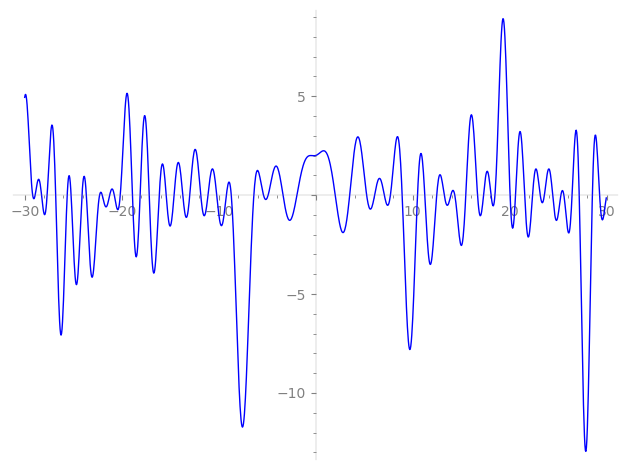| L(s) = 1 | + (1.06 − 0.928i)2-s + (−0.187 + 1.72i)3-s + (0.275 − 1.98i)4-s + (2.33 − 1.34i)5-s + (1.39 + 2.01i)6-s + (1.11 + 2.39i)7-s + (−1.54 − 2.36i)8-s + (−2.92 − 0.645i)9-s + (1.23 − 3.60i)10-s + (−1.22 − 0.706i)11-s + (3.35 + 0.845i)12-s + (2.46 + 1.42i)13-s + (3.41 + 1.51i)14-s + (1.88 + 4.26i)15-s + (−3.84 − 1.09i)16-s + (−1.23 + 0.712i)17-s + ⋯ |
| L(s) = 1 | + (0.754 − 0.656i)2-s + (−0.108 + 0.994i)3-s + (0.137 − 0.990i)4-s + (1.04 − 0.602i)5-s + (0.571 + 0.820i)6-s + (0.422 + 0.906i)7-s + (−0.546 − 0.837i)8-s + (−0.976 − 0.215i)9-s + (0.391 − 1.13i)10-s + (−0.369 − 0.213i)11-s + (0.969 + 0.244i)12-s + (0.683 + 0.394i)13-s + (0.914 + 0.405i)14-s + (0.485 + 1.10i)15-s + (−0.962 − 0.272i)16-s + (−0.299 + 0.172i)17-s + ⋯ |
\[\begin{aligned}\Lambda(s)=\mathstrut & 252 ^{s/2} \, \Gamma_{\C}(s) \, L(s)\cr =\mathstrut & (0.923 + 0.384i)\, \overline{\Lambda}(2-s) \end{aligned}\]
\[\begin{aligned}\Lambda(s)=\mathstrut & 252 ^{s/2} \, \Gamma_{\C}(s+1/2) \, L(s)\cr =\mathstrut & (0.923 + 0.384i)\, \overline{\Lambda}(1-s) \end{aligned}\]
Particular Values
| \(L(1)\) |
\(\approx\) |
\(1.96552 - 0.392497i\) |
| \(L(\frac12)\) |
\(\approx\) |
\(1.96552 - 0.392497i\) |
| \(L(\frac{3}{2})\) |
|
not available |
| \(L(1)\) |
|
not available |
\(L(s) = \displaystyle \prod_{p} F_p(p^{-s})^{-1} \)
| $p$ | $F_p(T)$ |
|---|
| bad | 2 | \( 1 + (-1.06 + 0.928i)T \) |
| 3 | \( 1 + (0.187 - 1.72i)T \) |
| 7 | \( 1 + (-1.11 - 2.39i)T \) |
| good | 5 | \( 1 + (-2.33 + 1.34i)T + (2.5 - 4.33i)T^{2} \) |
| 11 | \( 1 + (1.22 + 0.706i)T + (5.5 + 9.52i)T^{2} \) |
| 13 | \( 1 + (-2.46 - 1.42i)T + (6.5 + 11.2i)T^{2} \) |
| 17 | \( 1 + (1.23 - 0.712i)T + (8.5 - 14.7i)T^{2} \) |
| 19 | \( 1 + (-1.48 + 2.56i)T + (-9.5 - 16.4i)T^{2} \) |
| 23 | \( 1 + (-1.67 + 0.967i)T + (11.5 - 19.9i)T^{2} \) |
| 29 | \( 1 + (-0.423 - 0.733i)T + (-14.5 + 25.1i)T^{2} \) |
| 31 | \( 1 + 9.87T + 31T^{2} \) |
| 37 | \( 1 + (5.49 - 9.51i)T + (-18.5 - 32.0i)T^{2} \) |
| 41 | \( 1 + (5.99 + 3.46i)T + (20.5 + 35.5i)T^{2} \) |
| 43 | \( 1 + (5.96 - 3.44i)T + (21.5 - 37.2i)T^{2} \) |
| 47 | \( 1 - 10.6T + 47T^{2} \) |
| 53 | \( 1 + (6.58 + 11.4i)T + (-26.5 + 45.8i)T^{2} \) |
| 59 | \( 1 - 1.42T + 59T^{2} \) |
| 61 | \( 1 + 2.03iT - 61T^{2} \) |
| 67 | \( 1 - 8.74iT - 67T^{2} \) |
| 71 | \( 1 + 1.95iT - 71T^{2} \) |
| 73 | \( 1 + (-7.16 + 4.13i)T + (36.5 - 63.2i)T^{2} \) |
| 79 | \( 1 + 11.8iT - 79T^{2} \) |
| 83 | \( 1 + (-2.85 - 4.94i)T + (-41.5 + 71.8i)T^{2} \) |
| 89 | \( 1 + (-5.75 - 3.32i)T + (44.5 + 77.0i)T^{2} \) |
| 97 | \( 1 + (-13.1 + 7.57i)T + (48.5 - 84.0i)T^{2} \) |
| show more | |
| show less | |
\(L(s) = \displaystyle\prod_p \ \prod_{j=1}^{2} (1 - \alpha_{j,p}\, p^{-s})^{-1}\)
Imaginary part of the first few zeros on the critical line
−11.85080617610590575933829206907, −11.10548342227404216880962089461, −10.20465094194042664005658649623, −9.210574740763359643980023999373, −8.705632308223816812362262392652, −6.37787809225468958479912454978, −5.38446002777403559562764868409, −4.90566863666990757999671506605, −3.37067205783138889242455249272, −1.93665883195229071762941112635,
2.01021835965664099681674113601, 3.49877376018804437401932814624, 5.25005732206147397672394555994, 6.07134621644968291931283276736, 7.07302833167671499371427197732, 7.69985650974069174340949159666, 8.909763605008216102997218208259, 10.49158849978284576812319136690, 11.24146331126776395466538459975, 12.47251281300363335408145228029

